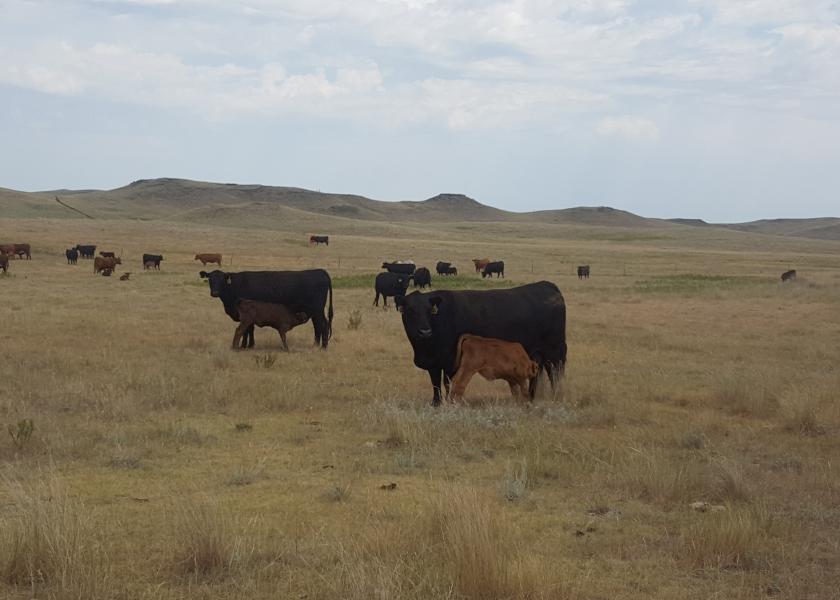Supplementing Beef Cows Grazing Dormant Native Range

A ranching operation is a sustainable forage production and utilization enterprise. With good management, forage is an extremely valuable renewable resource and represents the most cost-effective feed resource to maintain health and productivity in cow-calf operations. A combination of excellent forage production and grazing management practices, cattle genetics that match the forage resources, and a well-timed calving season results in minimum reliance on purchased and harvested feeds. Nevertheless, specific nutrients must be supplemented at times.
Conservation Reserve Program (CRP) contracts will expire on about 3 million acres in the United States on September 30, 2021. One option for land that has been sitting idle under CRP contract for many years is to graze the stockpiled Native grasses established when the land went into a CRP contract. If this is the option of choice, or if you have stockpiled native range grown this year to use for fall and winter grazing after it has gone dormant, supplementation of cows will be necessary.
Identifying a Supplemental Need
The first step in implementing and maintaining an efficient supplementation program for grazing cows is to identify specific supplementation needs. The producer must identify specific nutrients not provided in adequate quantity from the grazed forage to meet the animal’s nutrient requirements. For grazing cattle, this is a difficult task because forage quality is constantly changing and so are the animal’s nutrient requirements. Knowledge of these two factors is the basis for effective and efficient supplementation. Years of research and current technology provides guidance in developing an effective supplement development and evaluation plan. The following steps provide a logical approach in identifying a supplemental need and evaluating supplement alternatives.
- Determine the nutrient requirements of cows for the appropriate stage of production.
- Estimate the amount of nutrients cows will receive from forage.
- Subtract item No. 1 from item No. 2 to determine if a nutrient deficiency or excess exists.
- Evaluate supplement alternatives.
It should be noted that all possible combinations of the above factors are difficult to determine because there are infinite possibilities. Computer software, such as OSU Cowculator, can better pinpoint an animal’s nutrient requirement at a specific time and in a specific stage of production. These and other useful tools can be found at beefextension.com.
Anticipating nutrients supplied by the forage base is the most difficult task in grazing cattle nutrition. The formula for nutrient intake is simple: forage intake multiplied by concentration of available nutrients such as Crude Protein (CP) and Total Digestible Nutrients (TDN) in the forage.
Beware, many factors influence both components in this formula. For example, the CP and TDN values of dormant native range plants in pastures that have been in the CRP program would be lower than for native grass grown this summer. Forage intake is dramatically influenced by forage quality as well as forage availability, and both of these factors can vary dramatically from year to year and month to month.
Once nutrient requirements have been established and a reasonable estimate of the nutrient contribution of the forage has been made, determining supplemental needs is simply a comparison of the two. Again, this comparison is easily and perhaps more accurately made using computer software, such as OSU Cowculator.
Supplementation Priorities
If supplementation is the goal for cattle grazing low quality forage, priority should first be placed on meeting the protein requirement to maximize forage intake and digestion. Many years of research have consistently shown that protein supplementation is extremely effective for cattle grazing protein-deficient forage. In fact, energy supplementation will not be effective if dietary protein is deficient.
Once the producer ensures that the supplementation program will meet the protein requirement, energy intake should be evaluated. The decision must be made whether the cattle need to maintain body weight and condition, gain weight and condition or can be allowed to lose some weight and condition. This decision will dictate how much supplemental energy should be provided.
Finally, vitamin and mineral requirements should be compared to expected intake and have potential deficiencies identified. Vitamins and minerals are important but priority should be given to protein and energy nutrition first. Protein and energy are needed in much greater quantities and have the potential for greater impact on animal performance and efficiency of forage utilization.







